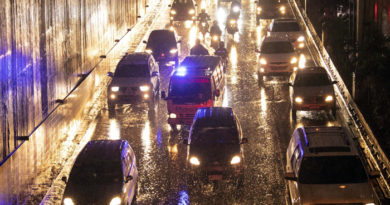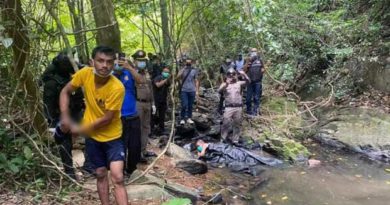JAKARTA: The News We’ve All Been Waiting For: Jakarta MRT Open for Public in March
.
Jakarta. After years of exasperating stop-start development, Indonesia’s first mass rapid transit network is finally set to be open for public next month.
All 16 train carriages have been put on a trial run on the completed MRT line since December to asses on-time performance, put the electronic passenger gates on each platform through their phases and test the reaction time from emergency personnel.
A small group of government officials, ambassadors and journalists have been invited to trial the first MRT in the past week.
Mass Rapid Transit Jakarta, the operator of the network, also plans to open the MRT for a public trial run on March 12.
Workers are now busy touching up the paint and polishing fittings on the MRT stations’ interior and walkways.
If the public trial run goes off without a hitch, the country’s first MRT will start commercial operation by the end of next month.
.
.
ADS by Cloud 9:
.
– SPACE RESERVE FOR YOUR ADVERTISEMENT –
.
.
Route
The first MRT line will run from Lebak Bulus in South Jakarta to the Hotel Indonesia traffic circle in Central Jakarta.
The MRT train is expected to travel the 15.7-kilometer track in 30 minutes, less than half the time cars usually take to travel the same route through heavy traffic.
There will be 13 stops along the route.
The overground stations are Lebak Bulus, Fatmawati, Cipete Raya, Haji Nawi, Blok A, Blok M and Sisingamangaraja.
The six underground stations are Senayan, Istora, Bendungan Hilir, Setiabudi, Dukuh Atas and Bundaran Hotel Indonesia.
.
.
ADS by Cloud 9:
.
– SPACE RESERVE FOR YOUR ADVERTISEMENT –
.
.
Capacity
A single MRT train comprises six carriages which can carry up to 1,950 passengers. By 2024, the MRT is expected to carry up to 430,000 passengers a day.
EU Ambassador to Indonesia Vincent Guérend has sung his praises for the Jakarta MRT, saying he loved the modern look and its well-thought-out amenities.
When he went on his trial run last week, the ambassador remarked the Jakarta MRT even appeared more modern than some old subway trains in European countries.

.
.
ADS by Cloud 9:
.
– SPACE RESERVE FOR YOUR ADVERTISEMENT –
.
.
Fares
The Jakarta Provincial Government will determine fares on the network, but MRT Jakarta expects a single trip should not cost more than Rp 8,500-Rp 10,000 (60-70 cents).
This was the fare stated in the company’s proposal to the administration, taking into account government subsidy.
A single trip fare of Rp 8,500 will be less than half of the Rp 18,000 true cost of running the trains each way. If the fare is approved, MRT Jakarta expects to handle up to 130,000 passengers a day.
The Jakarta City Council meanwhile has said the city must not pay more in subsidy than what the customer pays in fares.
.
.
ADS by Cloud 9:
.
– SPACE RESERVE FOR YOUR ADVERTISEMENT –
.
.
Naming Rights
MRT Jakarta is selling naming rights for eight stations on the Lebak Bulus-Bundaran Hotel Indonesia line, which allow a company to attach its brand name to a station for 10 years.
Naming rights for three stations have already been bought by state-controlled lender Bank Negara Indonesia for the Dukuh Atas-BNI Station; another state-owned lender Bank Mandiri for the Istora-Mandiri Station; and Astra International for the Setiabudi-Astra Station.
The naming rights for five more stations—Bendungan Hilir, Blok M, Senayan, Lebak Bulus and Sisingamangaraja—are still up for auction.
.
.
ADS by Cloud 9:
.
– SPACE RESERVE FOR YOUR ADVERTISEMENT –
.
.
Investments
The Lebak Bulus-Bundaran Hotel Indonesia line makes up Phase 1 of the Jakarta MRT network which will eventually cover a total distance of 110 kilometers, linking the sprawling city’s north, south, east and west.
Japan International Cooperation Agency (JICA) loaned Rp 16 trillion to the Jakarta administration for the Phase 1 construction.
Suppliers & Contractors
The MRT trains are produced by Japanese rail car manufacturer Nippon Sharyo, a subsidiary of Central Japan Railway Company.
Jakarta MRT bought 16 of their made-in-Japan trains for Rp 1.6 trillion. All of them arrived in Jakarta last year.
A consortium of Japanese constructor Shimitsu Kobayashi, state-owned builder Wijaya Karya and Jaya Konstruksi worked on two sections of the underground track.
Another consortium of Sumitomo Mitsui and Hutama Karya worked on the remaining underground track.
Japanese railway company Tokyu and state-owned constructor Wijaya Arya built two sections of the elevated track.
Japanese firms Obayashi and Shimizu formed a joint venture with local firm Jaya Konstruksi to build the remaining elevated track.

.
.
ADS by Cloud 9:
.
– SPACE RESERVE FOR YOUR ADVERTISEMENT –
.
.
Future Lines
On Oct. 23 last year, the Japan International Cooperation Agency (JICA) agreed to loan Rp 9.4 trillion to the Jakarta Provincial Government for Phase 2 of the MRT project to build a line from Sarinah to Kota.
This is the first of two installments which will be used to fund the first stage of construction in Phase 2.
Phase 2: Sarinah to Kota
Track length: 7.8 kilometers
7 underground stations: Sarinah, Monas, Harmoni, Sawah Besar, Mangga Besar, Glodok, Kota
Phase 2 construction is set to begin in March 2019.
Phase 3: Cikarang to Jakarta
Track length: 87 kilometers
This line will run from east to west, connecting Cikarang and Balaraja with Jakarta.
Phase 3 construction is planned to begin in 2020.
.
ADS by Cloud 9:
.
– SPACE RESERVE FOR YOUR ADVERTISEMENT –
.
.
.

All photographs, news, editorials, opinions, information, data, others have been taken from the Internet..aseanews.net | [email protected] / For comments, Email to : Aseanews.net









